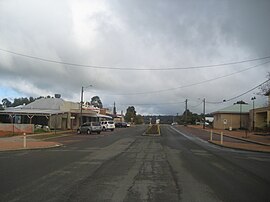Williams, Western Australia
|
Williams Western Australia |
|||||||||||||
|---|---|---|---|---|---|---|---|---|---|---|---|---|---|

Williams
|
|||||||||||||
| Coordinates | 33°02′00″S 116°53′00″E / 33.03333°S 116.88333°ECoordinates: 33°02′00″S 116°53′00″E / 33.03333°S 116.88333°E | ||||||||||||
| Population | 914 (2011 census) | ||||||||||||
| • Density | 0.39826/km2 (1.0315/sq mi) | ||||||||||||
| Established | 1860s | ||||||||||||
| Postcode(s) | 6391 | ||||||||||||
| Area | 2,295 | ||||||||||||
| Location | |||||||||||||
| LGA(s) | Shire of Williams | ||||||||||||
| State electorate(s) | Wagin | ||||||||||||
| Federal Division(s) | O'Connor | ||||||||||||
|
|||||||||||||
Williams is a town located in the Wheatbelt region of Western Australia, 161 kilometres (100 mi) south-southeast of the state capital, Perth along Albany Highway and 32 kilometres (20 mi) west of Narrogin. The Williams River passes through the town. At the 2011 census, Williams had a population of 914.
Williams is named after the Williams River which flows nearby. The river was discovered by Captain Thomas Bannister in 1831 while leading the first overland expedition from the Swan River Colony to King George Sound (now Albany), and was first shown on an 1833 map. More than likely, the name honours King William IV, who reigned in the United Kingdom from June 1830 until June 1837.
The first claims on land in the area occurred in 1832. In 1835 a party led by Governor James Stirling and John Septimus Roe surveyed a route joining King George Sound with York via Williams to encourage inland settlement. No settlement occurred until after Lieutenant Henry Bunbury explored the region in 1836, despite his assessment that "on the Williams the land is generally very bad and the water brackish."
After the building of Albany Highway by convicts in the 1850s, Williams became an important stopover point for passengers and changing of horses and became the main centre in the district. The Williams Hotel was erected in 1871, and a Road Board (predecessor to the current Shire Council) first convened in 1877.
...
Wikipedia

